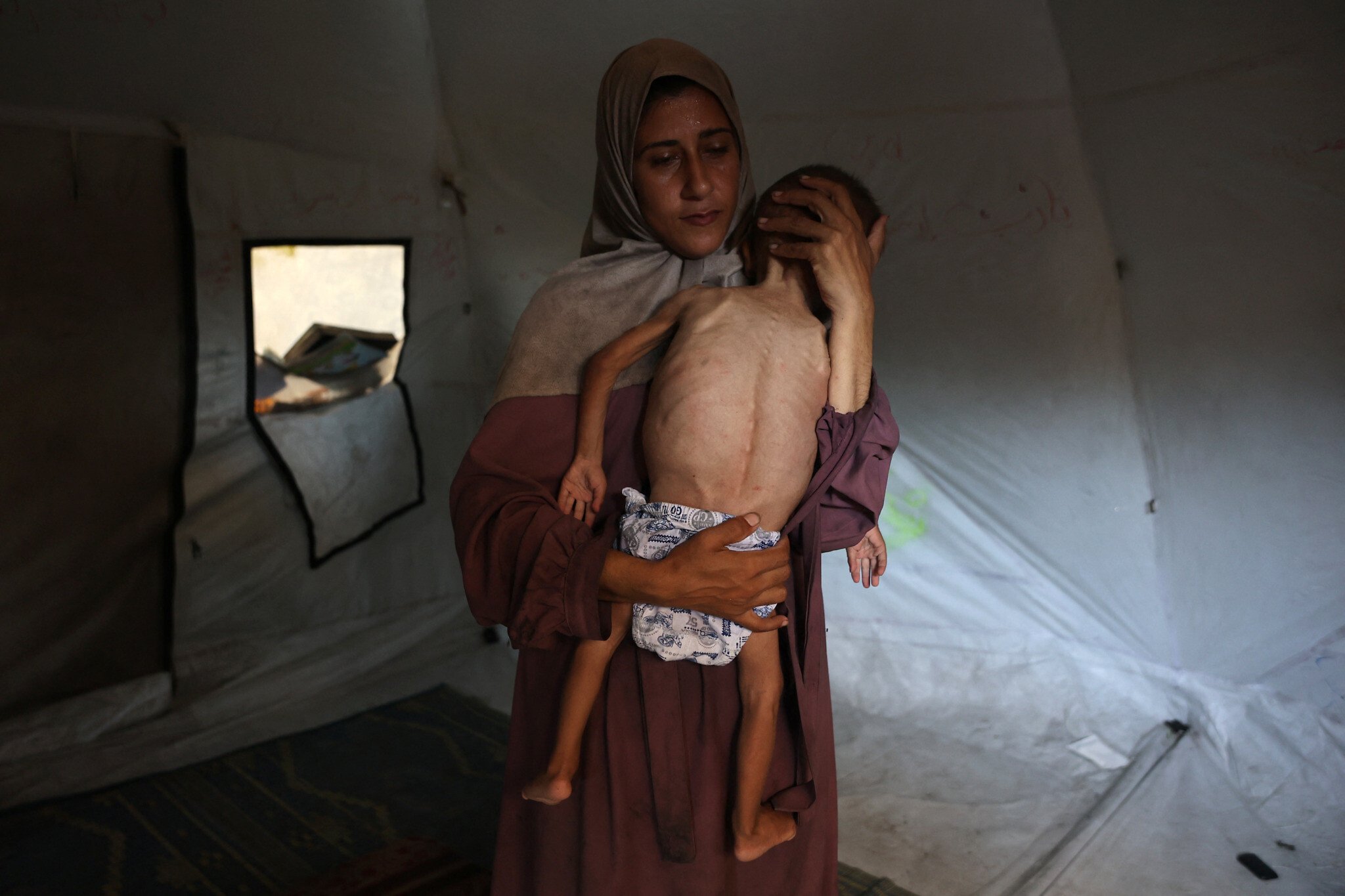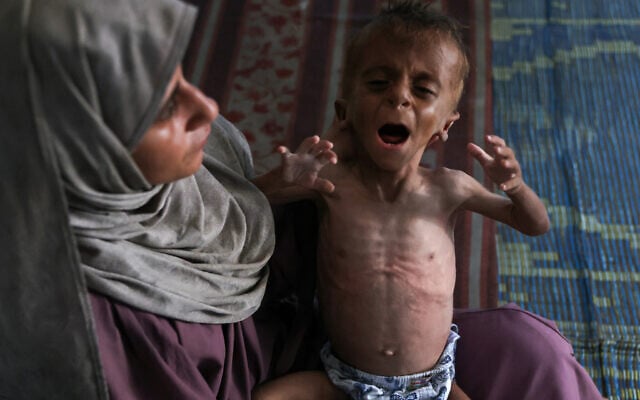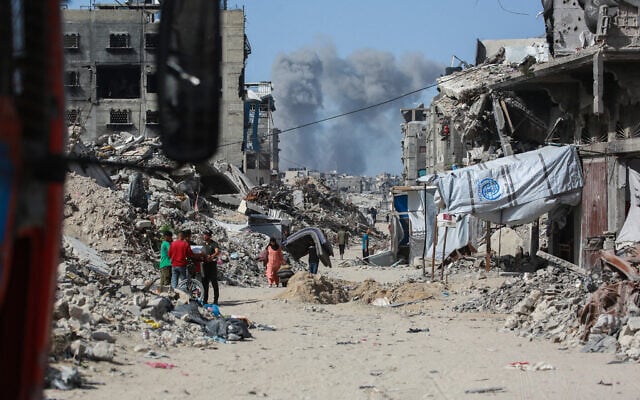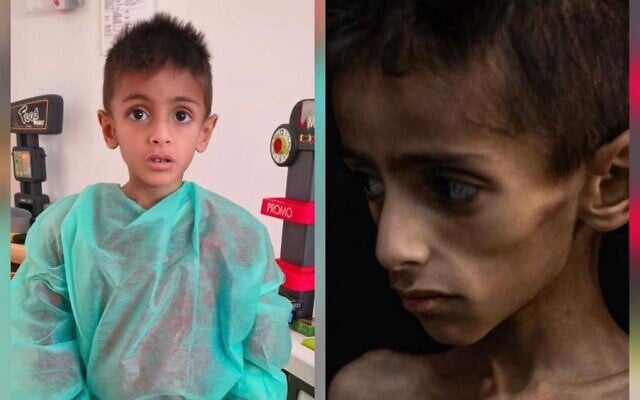



The New York Times issued a correction on Tuesday, after it published a front-page image last week of an emaciated child to illustrate widespread hunger in Gaza without noting that the boy suffers from health problems that predate the ongoing war.
“Children in Gaza are malnourished and starving, as New York Times reporters and others have documented,” the newspaper said in a written statement. “We recently ran a story about Gaza’s most vulnerable civilians, including Mohammad Zakaria el-Mutawaq, who is about 18 months old and suffers from severe malnutrition.
“We have since learned new information, including from the hospital that treated him and his medical records, and have updated our story to add context about his pre-existing health problems. This additional detail gives readers a greater understanding of his situation,” it said.
A correction was added to the article accompanying the photo online. The statement was posted on X to The New York Times’ public relations account — which has some 89,000 followers; it was not posted to The New York Times’ main X account, which has 55 million.
The photograph, which dominated the Times’ front page on Friday, shows the boy, visibly malnourished, in the arms of his mother, Hidaya. She told the newspaper, according to its caption, that Mohammed “was born healthy but was recently diagnosed with severe malnutrition.”
Images of al-Mutawaq also appeared in Sky News, The Guardian, The Daily Mail, and the Times of London, with similar captions, some of which — including in The New York Times’ online edition — also claimed without clear evidence that “Mohammed’s father was killed last year when he went to seek food.”
An image of the child in his mother’s arms also occupied the entire front page of the UK’s Daily Express newspaper last week, with the headline: “FOR PITY’S SAKE STOP THIS NOW: The suffering of little Muhammad clinging on to life in Gaza hell shames us all.”
The New York Times acknowledged on Tuesday, in its updated article, that “Mohammed, according to his doctor, had pre-existing health problems affecting his brain and his muscle development.”
“But,” the newspaper noted, “his health deteriorated rapidly in recent months as it became increasingly difficult to find food and medical care, and the medical clinic that treated him said he suffers from severe malnutrition.”
The correction came after freelance investigative journalist David Collier reported on his website Monday that a May 2025 medical report from Gaza stated that Mohammed was diagnosed with cerebral palsy and suffers from hypoxemia, possibly linked to a suspected genetic disorder.
Collier also noted in his article that other photos from the same sets, used by major outlets, showed Mohammed’s mother and his older brother, who look to be of normal weight.
However, Collier himself acknowledged that Mohammed “has needed specialist medical supplements since birth,” indicating that he is also likely further suffering due to the limited aid flow into Gaza, as medical equipment is in short supply and the Strip’s health system has all but collapsed.
Collier also challenged the claim made in some captions that “Mohammed’s father was killed last year when he went to seek food.”
Collier said he had identified the boy’s father as Zakaria Ayoub al-Mutawaq, who was reported killed in an Israel Defense Forces attack on October 28, 2024, along with three others, on Al-Qassabeeb Street in northern Gaza’s Jabalia.
The elder al-Mutawaq’s death came within days of a video published by Hamas of the group’s operatives targeting Israeli soldiers on that same street. Six Israeli troops were killed in the area during a four-day period coinciding with the clip.
It was not immediately clear if there was evidence linking the elder al-Mutawaq to the boy beyond their shared last name.
In the last several months, near-daily incidents have been reported across the Strip in which Palestinians seeking aid have been killed, sometimes by Israeli fire, in what the military has presented as crowd control attempts. Israeli ground troops only started to operate near aid sites in May 2025, however.
On Monday, The Times of London published an article about Collier’s story, though it neither endorsed nor rejected his findings.
Neither Sky News, nor The Guardian or The Daily Mail had added corrections to their articles as of midday Wednesday.
Former prime minister Naftali Bennett, responding to The New York Times’ correction, accused the newspaper of intentionally spreading a “blood libel,” in a post to X on Tuesday night.
“This is simply unbelievable,” he wrote. “After generating a tsunami of hate towards Israel with that terrifying picture, the NYT now quietly admits that the boy has preexisting conditions. NYT, you knew that Hamas uses babies with preexisting illnesses. We’ve been saying this for months now. You knew exactly what this picture would cause. This is a blood libel in 2025. Have you no shame?”
Collier’s article came as Israel charged that another widely circulated image of an emaciated Palestinian child has been used to falsely accuse Israel of starving children in Gaza..
The image in question was of 5-year-old Osama al-Rakab, who suffers from a serious genetic illness and who exited Gaza on June 12 to receive treatment abroad, with Israel’s approval.
The UN-backed Integrated Food Security Phase Classification reported Tuesday that the “worst-case scenario of famine is currently playing out in the Gaza Strip,” predicting “widespread death” in the absence of immediate action.
Two days earlier, in light of the situation, Israel had started to pause all fighting in large swaths of the Strip for 10 hours each day, while facilitating a surge of aid by land and air.
From March to May of this year, Israel blocked all humanitarian aid from entering the Strip, including food and medicine.
At the time, Jerusalem estimated that enough aid had accumulated to last several months, and said that sending more would strengthen the Hamas terror group.
Since ending that blockade, Israel has relied heavily on the US- and Israel-based Gaza Humanitarian Foundation. Hamas authorities say near-daily fatal shootings near GHF sites have killed more than 1,000 people. The IDF says the number is exaggerated.



